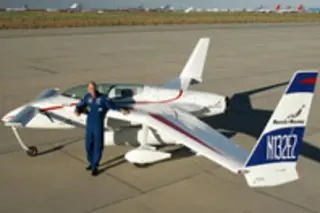A rocket-powered plane trailing a bright blaze of flame streaked across the Wisconsin sky yesterday, as spectators at the EAA AirVenture air show got the first glimpse of a new sport called rocket racing. But in a setback, the Rocket Racing League wasn't able to send two rockets soaring into the sky to race against each other as hoped, as the Federal Aviation Administration is still in the process of approving the second aircraft.
[T]he Rocket Racing League is aimed at melding human spaceflight with NASCAR-like competitions in the sky. The racers are designed to belch 15-foot (4.5-meter) flames from their engines that can be easily seen by spectators, and carry limited amounts of rocket fuel to fly through a three-dimensional aerial race course [SPACE.com].
League officials hope to eventually let onlookers follow the planes' progress through the looping flight path by projecting videos from cockpit cameras onto huge screens, ...














